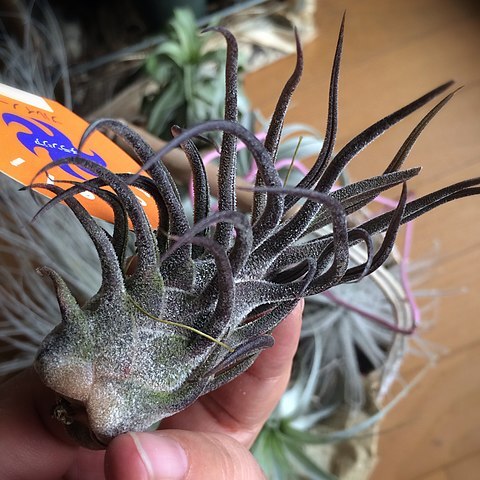Plant acaulescent, 8-23 cm tall, with about 10-20 white-tomentose (often ferrugineous when dry) leaves, the sheaths forming a small pseudo-bulb. Leaves 7-25 cm long, exceeding the inflorescence; sheaths much inflated-convex, abruptly contracted into the blades, chartaceous, suborbicular or elliptic, 2-4.8 x 2-4.3 cm, with broad membranaceous and often purple-red margins, densely subappressed-lepidote to somewhat ferrugineously tomentose-lepidote at the apex, pale-brown, often deep purple inside; blades suberect, often slightly flexuous or secund, fleshy coriaceous, flexible, involute-subulate, 5-21 cm long, 0.2-0.5 cm in diam., filiform-attenuate, very densely white or somewhat ferrugineously tomentose-lepidote. Inflorescence simple or rarely digitately compound of 2-4 spikes, 5-15 cm long, densely tomentose-lepidote; scape erect, 5-8 cm long, 2-3 mm in diam., densely concealed by its bracts and the leaves; scape bracts foliaceous, suberect, with densely imbricate sheaths, the upper ones more oblong and acutish; axis very short and hidden; primary bracts as the upper scape bracts, subspreading with the spikes, shorter than or exceeding the spikes by the foliaceous blade; peduncle suberect or spreading, less than 1 cm long, only prophyllate; spikes (broadly) elliptic, complanate, 4-6.5 x 1.8-4.5 cm, acutish, densely and distichously 3-6(-15)-flowered, with 1 to a few sterile bracts at the base and apex; rachis hidden, nearly straight, angled, densely tomentose-lepidote; floral bracts suberect, imbricate, thin-coriaceous, with even surface, elliptic, 2-2.9 cm long, 4-5 times as long as the internodes, nearly twice as long as the sepals, acutish or obtuse and obscurely apiculate, obscurely carinate at the extreme apex, pale silvery green, tinged with, or wholly dull rose-red. Flowers tubular-erect, contiguous, sessile; receptacle obconic, bicarinate, ca. 2 mm long; sepals very thin-coriaceous, with even surface, elliptic, 1.3-1.9 cm long, with broad membranaceous margins, rounded or obtuse, then obscurely acuminate, anteriorly short connate or almost free, posterior ones less than half connate and bluntly carinate at the base, sparsely appressed-lepidote at both sides or subglabrous; petals ligulate, coiled at the extreme apex, ca. 3 cm long, obtuse or acute, violet; stamens much exceeding the petals, the shortest 3 about equaling the pistil, the longest exceeding it, filaments flat, but exceeding part dilated, terete and violet, anthers dorsifixed (at 1/3), over 3 mm long; ovary ovoid(?), contracted into the slender style, stigmas linear, flattened and twisting. Capsule cylindric, to ca. 5.5 cm long, attenuately subacute, short-beaked.
More
Plants usually single, rarely clustering, flowering to 10 cm. Stems short. Leaves 5--10, many-ranked, contorted or secund-spreading, gray-green to silver, 6--10 ´ 0.3--0.5 cm, densely pruinose-scaly, scales coarse; sheath dark chestnut brown within, ovate to elliptic, conspicuously inflated, forming small pseudobulb, 1.5--3 cm wide; blade linear-subulate, semisucculent, margins involute, apex attenuate. Inflorescences: scape inconspicuous, usually ascending, 1--3 cm, 2--3 mm diam.; bracts densely imbricate, erect to spreading, like leaves but gradually smaller; sheath of bracts narrowing abruptly into blade; single spikes, usually ascending, pinnate, broadly elliptic, compressed, 2--3 ´ 1.2--2.4 cm, apex acute to obtuse. Floral bracts imbricate, erect, pink, broad (covering all or most of rachis, rachis not visible at anthesis), ovate, keeled, 2--2.2 cm, thin-leathery, base not visible at anthesis, apex broadly acute, surfaces densely scaly, venation even to slight. Flowers 3--12, conspicuous; sepals free, elliptic, adaxial pair keeled, 1.2--1.8 cm, thin-leathery, veined, apex obtuse, surfaces glabrous; corolla tubular; petals erect, blue-violet, ligulate, to 3 cm; stamens exserted; stigma exserted, conduplicate-spiral. Fruits to 3.5 cm.

